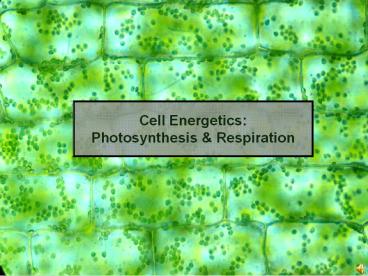Cell Energetics: Photosynthesis - PowerPoint PPT Presentation
Title:
Cell Energetics: Photosynthesis
Description:
Cell Energetics: Photosynthesis & Respiration Carbon Carbon forms millions of compounds, both simple and complex All living things contain carbon Living things cycle ... – PowerPoint PPT presentation
Number of Views:145
Avg rating:3.0/5.0
Title: Cell Energetics: Photosynthesis
1
Cell Energetics Photosynthesis Respiration
2
Carbon
- Carbon forms millions of compounds, both simple
and complex - All living things contain carbon
- Living things cycle carbon from the air
(inorganic gas form) to the solid form (organic)
and back to the air - Light from the sun provides the energy for
photosynthesis, the process of making organic
compounds such as sugar - The suns energy is stored the chemical bonds of
sugars and other carbohydrates - Carbohydrates are used by most living things to
provide energy for LIVING
3
What is the Global Carbon Cycle?
- The movement of carbon between the atmosphere,
soil, ocean, living things, and fossil fuels - Carbon exists primarily as
- - Gas, carbon dioxide (CO2), in Earths
atmosphere - - Organic carbon in living and dead organisms.
- Atmospheric carbon is constantly recycled,
mostly by green plants and algae, to produce
oxygen
4
The Global Carbon Cycle
CO2 other greenhouse gases
respiration
Photosynthesis
Green plants
Emissions from burning fossil fuel
Algae cyanobacteria
Dissolved carbon
5
Photosynthesis and Respiration in the Global
Carbon Cycle
Creates stored Energy-ATP
Carbohydrates Oxygen
Photosynthesis
Respiration
Carbon dioxide Water
6
A few types of organisms do not need sunlight and
photosynthesis as a source of energy.
- Some organisms live in places that never get
sunlight. - In chemosynthesis, chemical energy is used to
build carbon-based molecules. - similar to photosynthesis
- uses chemical energy instead of light energy
- occurs where light cannot penetrate-deep ocean
Biology-McDougal Littell 2008
7
Mitochondrion
Nucleus
Chloroplasts
A cell has some remarkable organelles!!! Is this
plant or animal?
8
Super Fun Activity!
- Compare and contrast the structure and function
of a chloroplast and a mitochondrion - Make a poster
- Make a PowerPoint
- Make a podcast
- Make a storybook
- Make a 3D model with explanation
MC.3.B.1
9
The Chloroplast is Remarkable Organelle
Stroma
Thylakoid
Stroma space/matrix inside the chloroplast
where carbohydrate is synthesized Thylakoid
structures with chlorophyll and light reaction
center
10
The Basic Process of Photosynthesis
light energy
CO2 H2O
CH2O O2
carbon dioxide
water
carbohydrates
oxygen
11
Photosynthesis in chloroplast is divided into
The Light Reactions- Light Dependent
The Dark Reactions- Light Independent
12
MUST occur in the presence of light
The Light Reactions- Light Dependent
CAN occur in the presence of light, but works
better in the dark
The Dark Reactions- Light Independent
13
Keeping track of the oxygen atom in photosynthesis
Cornelius van Niel (1897-1985) Standford
University
Used radioactive-labeled oxygen in water and
unlabeled carbon dioxide in photosynthesis
experiments Found that oxygen gas produced comes
from water Postulated that the oxygen atom in
carbohydrates must be from carbon dioxide
14
H2O
O2
The Light Reactions
ADP
NADP
NADPH
ATP
The Dark Reactions
Carbohydrates
CO2 H2O
MC.3.B.4
15
Where do the reactions happen inside the
chloroplast?
H2O
CO2
Light reaction occurs on thylakoid membranes
Light reaction
Dark reaction
Dark reaction occurs in the stroma
O2
Carbohydrates
MC.3.B.4
16
Frameworks
Strand Molecules and Cells
Standard 3 Students shall demonstrate
an understanding of how cells obtain and use
energy
(energetics).
MC.3.B.1 Compare and contrast the structure and function of mitochondria and chloroplasts
MC.3.B.2 Describe and model the conversion of stored energy in organic molecules into usable cellular energy (ATP) glycolysis citric acid cycle electron transport chain
MC.3.B.3 Compare and contrast aerobic and anaerobic respiration lactic acid fermentation alcoholic fermentation
MC.3.B.4 Describe and model the conversion of light energy to chemical energy by photosynthetic organisms light dependent reactions light independent reactions
MC.3.B.5 Compare and contrast cellular respiration and photosynthesis as energy conversion pathways































